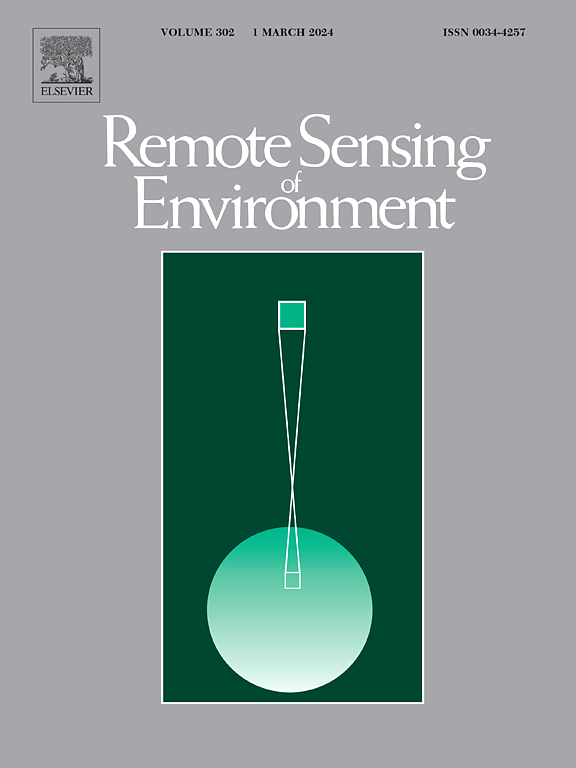Improved satellite-scale land surface temperature components retrieval with hotspot effect correction and temperature difference constraints
IF 11.4
1区 地球科学
Q1 ENVIRONMENTAL SCIENCES
引用次数: 0
Abstract
Land surface temperature (LST) plays an important role in Earth energy balance and water/carbon cycle processes and is recognized as an Essential Climate Variable (ECV) and an Essential Agricultural Variable (EAV). LST products that are issued from satellite observations mostly depict landscape-scale temperature due to their generally large footprint. This means that a pixel-based temperature integrates over various components, whereas temperature individual components are better suited for the purpose of evapotranspiration estimation, crop growth assessment, drought monitoring, etc. Thus, disentangling soil and vegetation temperatures is a real matter of concern. Moreover, most satellite-based LSTs are contaminated by directional effects due to the inherent anisotropy properties of most terrestrial targets. The characteristics of directional effects are closely linked to the properties of the target and controlled by the view and solar geometry. A singular angular signature is obtained in the hotspot geometry, i.e., when the sun, the satellite and the target are aligned. The hotspot phenomenon highlights the temperature differences between sunlit and shaded areas. However, due to the lack of adequate multi-angle observations and inaccurate portrayal or neglect of solar influence, the hotspot effect is often overlooked and has become a barrier for better inversion results at satellite scale. Therefore, hotspot effect needs to be better characterized, which here is achieved with a three-component model that distinguishes vegetation, sunlit and shaded soil temperature components and accounts for vegetation structure. Our work combines thermal infrared (TIR) observations from the Sea and Land Surface Temperature Radiometer (SLSTR) onboard the LEO (Low Earth Orbit) Sentinel-3, and two sensors onboard GEO (geostationary) satellites, i.e. the Advanced Himawari Imager (AHI) and Spinning Enhanced Visible and Infrared Imager (SEVIRI). Based on inversion with a Bayesian method and prior information associated with component temperature differences as constrained, the findings include: 1) Satellite observations throughout East Asia around noon indicate that for every 10 degrees change in angular distance from the sun, LST will on average vary by 0.6 K; 2) As a better constraint, the hotspot effect can benefit from multi-angle TIR observations to improve the retrieval of LST components, thereby reducing the root mean squared error (RMSE) from approximately 3.5 K, 5.8 K, and 4.1 K to 2.8 K, 3.5 K, and 3.1 K, at DM, EVO and KAL sites, respectively; 3) Based on a dataset simulated with a three-dimensional radiative transfer model, a significant inversion error may result if the hotspot is ignored for an angular distance between the viewing and solar directions that is smaller than 30. Overall, considering the hotspot effect has the potential to reduce inversion noise and to separate the temperature difference between sunlit and shaded areas in a pixel, paving the way for producing stable temperature component products.
基于热点效应校正和温差约束的改进卫星尺度地表温度分量检索
地表温度(LST)在地球能量平衡和水/碳循环过程中起着重要作用,是公认的基本气候变量(ECV)和基本农业变量(EAV)。由卫星观测发布的地表温度产品大多描绘景观尺度的温度,因为它们的足迹通常很大。这意味着基于像素的温度集成了多个分量,而温度单个分量更适合蒸散估算、作物生长评估、干旱监测等目的。因此,解开土壤和植被温度的纠缠是一个真正值得关注的问题。此外,由于大多数地面目标固有的各向异性特性,大多数星载lst受到方向效应的污染。定向效应的特点与目标的性质密切相关,并受视场和太阳几何形状的控制。在热点几何中,即当太阳、卫星和目标对准时,得到了一个奇异的角特征。热点现象突出了阳光照射区和阴影区之间的温差。然而,由于缺乏足够的多角度观测,以及对太阳影响的描述不准确或忽视,热点效应往往被忽视,成为卫星尺度上获得更好反演结果的障碍。因此,需要更好地表征热点效应,这里通过区分植被、阳光和阴影土壤温度分量并考虑植被结构的三分量模型来实现。我们的工作结合了近地轨道Sentinel-3上搭载的海陆表面温度辐射计(SLSTR)的热红外(TIR)观测数据,以及地球静止卫星上搭载的两个传感器,即先进的Himawari成像仪(AHI)和旋转增强可见光和红外成像仪(SEVIRI)。基于贝叶斯方法反演和约束条件下与分量温差相关的先验信息,结果表明:1)东亚地区正午前后的卫星观测表明,与太阳的角距离每变化10度,地表温度平均变化0.6 K;2)作为更好的约束条件,热点效应可以利用多角度TIR观测来提高对地表温度分量的检索,从而将DM、EVO和KAL站点的均方根误差(RMSE)分别从约3.5 K、5.8 K和4.1 K降低到2.8 K、3.5 K和3.1 K;3)基于三维辐射传输模型模拟的数据集,当观测方向与太阳方向之间的角距小于30°时,忽略热点可能会导致显著的反演误差。综上所述,考虑热点效应有可能降低反演噪声,并在一个像元内分离出阳光照射区域和阴影区域之间的温差,为生产稳定的温度分量产品铺平道路。
本文章由计算机程序翻译,如有差异,请以英文原文为准。
求助全文
约1分钟内获得全文
求助全文
来源期刊

Remote Sensing of Environment
环境科学-成像科学与照相技术
CiteScore
25.10
自引率
8.90%
发文量
455
审稿时长
53 days
期刊介绍:
Remote Sensing of Environment (RSE) serves the Earth observation community by disseminating results on the theory, science, applications, and technology that contribute to advancing the field of remote sensing. With a thoroughly interdisciplinary approach, RSE encompasses terrestrial, oceanic, and atmospheric sensing.
The journal emphasizes biophysical and quantitative approaches to remote sensing at local to global scales, covering a diverse range of applications and techniques.
RSE serves as a vital platform for the exchange of knowledge and advancements in the dynamic field of remote sensing.
 求助内容:
求助内容: 应助结果提醒方式:
应助结果提醒方式:


